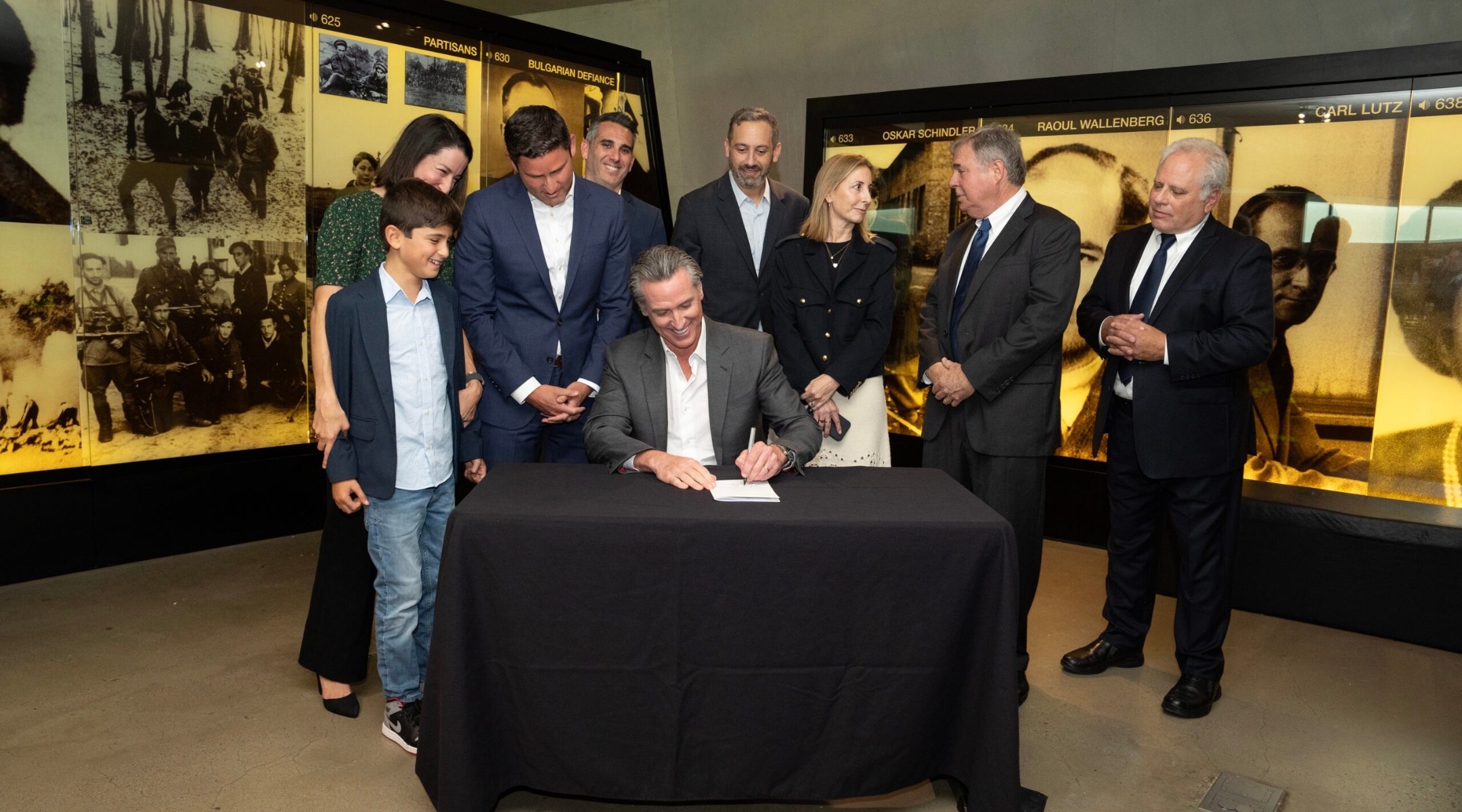California passes law to help Holocaust survivors and heirs recover Nazi-looted art
The law follows an appeals court decision that allowed a contested Pissarro painting to remain in the hands of a Spanish museum

CA Gov. Gavin Newsom signs a bill promoting the restitution of Nazi-looted art and personal property stolen during the Holocaust. (Office of CA Gov. Gavin Newsom)
(JTA) — California Gov. Gavin Newsom signed a bill Monday aimed at advancing the restitution of Nazi-looted art, as well as personal property stolen during the Holocaust and other eras of political persecution.
The legislation is a response to a court ruling that allowed a work by Camille Pissarro to remain in a Spanish museum instead of returning to the heirs of its original owners. The 1897 painting, called “Rue Saint-Honoré in the Afternoon, Effect of Rain,” belonged to Fritz and Lilly Cassirer, a Jewish couple who sold it under duress to escape the Nazis.
The painting by Pissarro, a French Jewish impressionist, now hangs in the Museo Nacional Thyssen-Bornemisza in Madrid. The museum has claimed ownership of the work under a “finders keepers” law of property ownership that is unique to Spain.
In January, the Ninth Circuit Court of Appeals was instructed to decide the case according to California state law. But it ruled that, even according to California, Spain’s legal system took precedence. “Rue Saint-Honoré,” according to that decision, belonged to the museum.
The new California law, signed at Los Angeles’ Holocaust Museum, clarifies that California law should take precedence in local Holocaust art restitution cases. It allows Californians “to bring an action for damages or to recover artwork or personal property, as defined, that was stolen or otherwise lost as the result of political persecution.”
According to the law, “California substantive law shall apply in actions to recover fine art,” and that “the true owner cannot be divested of ownership without actual discovery of their rights in, and the location and possessor of, the artwork.”
The legislation could send the decades-long ownership dispute over the Pisarro painting back to the courts — and award the painting to the Cassirers’ descendants.
“As a Holocaust survivor, the proudest day of my father’s life was in 1947, when he became a U.S. citizen,” David Cassirer, grandson of Fritz and Lilly Cassirer, told the LA Times. “He would be so happy, and grateful, that the people of the state of California have taken action to ensure the return of looted art to its rightful owners.”
Spain is one of the original 44 international signatories of the Washington Principles, a 1998 framework for restituting artwork stolen during the Holocaust. In 2018, Stuart Eizenstadt, the Secretary of State’s special advisor on Holocaust issues, named Spain as one of five countries that fell short on its commitment to the Washington Principles.
Authorities in New York City and around the world have made renewed efforts in recent years to restitute art that was sold under duress due to Nazi persecution. Earlier this year, 21 countries agreed to new standards in art restitution at a conference marking the 25th anniversary of the Washington Principles.
“Restitution is important, not just to get people their property back, but because it is a way to examine the true realities of the Holocaust and keep those facts in the public consciousness,” Sam Dubbin, an attorney representing the Cassirer family, told the Jewish Telegraphic Agency. “It’s stolen property. It’s the Holocaust, which makes it 1,000 times worse, but it’s still fundamentally stolen property. And no one should be able to keep stolen property.”
The oil painting was bought directly from Camille Pissarro by German Jewish industrialist and art collector Julius Cassirer, who passed it down to his son Fritz and his wife Lilly. Lilly was forced to sell the painting under duress in 1939 for about $360 at the time in order to obtain an exit visa for England. The money was then deposited into a bank account that she was not permitted to access.
The painting made its way around the world over the next several decades, eventually landing in the collection of Baron Heinrich Thyssen-Bornemisza, a Swiss art collector and the heir to a German steel fortune. Thyssen-Bornemisza sold his collection to the Kingdom of Spain in 1993, which established a foundation and museum in Spain in his name.
The Museo Thyssen did not respond to a request for comment.
After he learned of the location of the Pissarro painting, the couple’s sole heir, Claude Cassirer, sued for its return in 2005. He died five years later, and now his son David, his daughter Ava’s estate and the Jewish Federation of San Diego County are handling the case.
“For survivors of the Holocaust and their families, the fight to take back ownership of art and other personal items stolen by the Nazis continues to traumatize those who have already gone through the unimaginable,” Newsom said Monday. “It is both a moral and legal imperative that these valuable and sentimental pieces be returned to their rightful owners, and I am proud to strengthen California’s laws to help secure justice for families.”
A message from our CEO & publisher Rachel Fishman Feddersen
I hope you appreciated this article. Before you go, I’d like to ask you to please support the Forward’s award-winning, nonprofit journalism during this critical time.
We’ve set a goal to raise $260,000 by December 31. That’s an ambitious goal, but one that will give us the resources we need to invest in the high quality news, opinion, analysis and cultural coverage that isn’t available anywhere else.
If you feel inspired to make an impact, now is the time to give something back. Join us as a member at your most generous level.
— Rachel Fishman Feddersen, Publisher and CEO